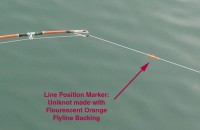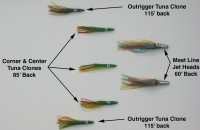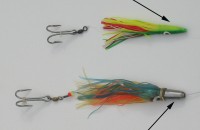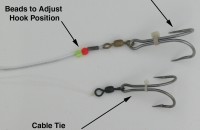By Bob Franko
I subscribed for years to the regurgitated nonsense that gets passed on from generation to generation about ways to catch tuna. You know what I’m talking about. How many times have you heard color is important, or this is the one everyone is catching them on, or you must use dark colors in the morning, light colors in the afternoon. I have seen every high tech gimmick known to man sold to the young albacore angler, with a smile and a promise of greatness.
I recently was walking by a so-called albacore trolling guru at a well-known boat show. I listened for several minutes as he repeated the same old tired formula that most of the outdoor experts seem to want young anglers to buy into. I can only come to a couple of conclusions: they either work for a tackle company that wants you to buy every color in the free world, or it’s just to much trouble to spend the time necessary on the water to think out of the box.
What most young albacore anglers fail to understand is these fish, contrary to what some might have you believe, didn’t graduate from Harvard.
The Tao of Fishing for Albacore
Efficiency
I believe efficiency will put more fish in the box than anything else you can do. Let me explain. I chase tuna on a daily basis, and have for many years. On most trips there is a window of opportunity. During this window they will eat the bottom of the boat. It may last 30 minutes, 1 hour, or it may go all day, but during this time you must be efficient. Anything less than a full court press at this time is just burning daylight.
There is nothing less efficient than a guy in the middle of the window standing in the back of the boat jerking his rod up and down trying to see where his lure is. Then to his amazement it goes off and he thinks life is good, but the reality of the situation is that that stop has produced only one fish. That is not efficiency when the rest of the spread never got in play. Would it not have made for a more exciting moment if all the gear got out, and now your son, father, brother all had fish hanging, screaming in both panic and pleasure as they battled this great fighting fish? There is only one thing better than a reel screaming after a jig strike, that is many reels screaming at the same time.
Rods and positions
 |
What has been (hopefully) affectionately nick named the Franko method by the largest fishing organisation in Northern California (Coastside Fishing Club, www.coastsidefishingclub.com), starts with marking you’re lines, and dedicating a rod to a permanent position. I use a piece of fluorescent trout leader tied with a uni knot to my main line, some guys use rubber bands, but the goal is to provide an exact distance mark so the team can free spool the gear out in a hurry, stopping at the mark and having that lure exactly placed in the spread. This system takes the guesswork out, and the end result is during that window instead of catching singles, you will maximize that window because multiples will be the rule.
It always amazes me when, after the fish come up, and they have bit for a couple of hours, the talk on the radio among the sport boats goes something like this. “Hey Bill that was incredible. I think they must have gone down. How many did you guys get?” “I got 9”. “I don’t know Harry, I must have something like that in the box. Bob how did your crew do.” “We got 17.” The message here was Bob and crew were not better fisherman, but they were more efficient.
Lures and Placement
 |
One of the most important things you can do is not provide tuna a choice when it comes to the lures in the spread. I believe this one factors denies more anglers the opportunity for an epic day than anything else. There is a reason to run all the same lures in your spread. What is important is how they swim, and where they swim. I want the same lure, and the same weight. I like a 2-½ ounce clone, they always swim right, even in rough water, compared to lighter jigs. And I fish the same color all day.
Let me explain it like this. Fish are no different than any other predator on the planet. If you watch a lion hunt, he is looking for the weak buffalo, he will always go after the one that is limping. Its nature’s way to weed out the weak. Albacore are the same way, they are looking for their weak buffalo, the odd ball, the one that is swimming a little different. I suggest, don’t give them a weak buffalo. When they come up don’t give them a choice, they’ll all gravitate to the weak one, the odd ball, and you’ll catch a lot of singles. Instead keep the lures all the same and let them eat them all!
There is nothing more exciting than seven positions going off, with only four guys on boat. There are descriptive words for this kind of event, but I better not use them. Let me illustrate my point even further. In my neck of the woods, cedar plugs get a lot of attention. They are very popular these days and in most cases are run in the middle way back. If you ask the angler why he runs it there he will tell you “I’m also fishing for a bluefin”. If you question him further he will tell you he has never caught a bluefin, but was told that is the way to get it done. There is validity to catching bluefin in that fashion (I personally would troll a kite), but let me suggest something else that will happen. That cedar plug becomes a weak buffalo so the angler thinks it’s the best lure that was ever made. It got bit more than anything else he had out, but in reality he brought the school up in the back of the spread, resulting in a lot more singles than he should have had, and missed the opportunity for a five banger.
If you must run a weak buffalo, at least run it in front of the spread. I position two meat lines with big jet heads 60ft behind the boat. I want that school of fish that are holding at 20 fathoms to look up and see all that movement from the bigger lures, and head in that direction. If I can get them there, everything else comes through. When positioning your gear you need to find your boat’s sweet spot. As I said every boat is different so experiment a little. I would start with my distances, and work from there.
For the record I run 60ft on the meatlines, 85ft on the two side back positions, and the center back position, the outriggers lures are at 115ft from my transom. I suggest that every boat is different when you talk about noise, wake, vibration, I believe because of these factors outboards are the least productive then comes outdrives, and the best-case scenario is a single screw diesel with a four bladed prop.
I would suggest on the couple of days they don’t want to bite like wild dogs, bring the spread closer to the transom. These fish have eyes as big as silver dollars, so let the prop wash help hide the line for you. And when working an area that has fish, never troll in a straight line for any length of time. Fish love to bite in a turn.
One other thing in regards to placement. My rod tips on my side rods are just above the water line, and my center position is on a flat line clip just below the gunnel. This is so lures not only swim better, but they are not influenced by the wind. Nothing is more inefficient than a tangle.
Remember there will be slow days in everyone future, I don’t care who you are. On those slow days a weak buffalo is the last thing you need, you need to get that multi hookup when they do show up.
Outriggers
There are several things to say about outriggers. I realize a lot of guys have those gunnel mount outriggers that only give you two positions up and when out are still up high. The problem with this is they are really affected by the wind. On days with anything above 15 knots of breeze, the wind puts big bellies in the line. This leads to tangles, and everything that goes with that. You can’t catch fish if you’re in the back of the boat trying to untangle a big mess for 30 minutes. I would recommend outriggers that mount to the wheelhouse, then place a stop in the maximum down position. The goal is to get them as low as you can without dipping them in the swell, and run them in the back positions in the spread. The wind will have less affect, and your lures won’t be coming out of the water.
Color
 |
It’s almost laughable at times when you hear the fleet talking about color. It seems like every time someone sticks a fish, he will suggest on the radio that his friends go to that color. It’s as if people believe that tuna wakes up in the morning saying I think I will eat one with red spots rather than green today.
Let me drop a bomb here, I know it is heresy to some of you, but the truth is that color doesn’t matter! I’m more concerned about how they swim and where they swim, than whether they have yellow in the skirt, or red. If you get nothing else out of this article remember this, location, and presentation will work for you regardless of what your target species is. The only thing I will say about color is this: if you must have different colors in the water make sure they’re all the same lure, this way, at a minimum, they will all swim the same. I take it a step further and run all the same color. I run a seven-strand 2-½ oz clone Mexican Flag or Pro Dolphin.
Hooks and Line and Other Tips
 |
There are a lot of ways to skin this cat. I personally top shot spectra with 50lb mono. This way I only have to replace the top shot if the wheels come of the cart.
Over the last couple years I have been using P line and have been more than satisfied. I do believe any quality line will get the job done.
If you have done enough long range, it does not take many trips to realize tuna get line shy. There are times when with live bait you must drop down to 15lb test to get bit. It’s that old eye’s as big as silver dollar thing, and there is nothing wrong with an albacore vision.
Its important to always put yourself in a position to succeed. You don’t know when you leave the slip that morning if it is a day that they will eat the bottom of the boat, in other words bite anything even rope, or whether its going to require something lighter.
I always straight tie 50lb test right to the swivel that holds the hook. Both are hidden in the skirt. I know some of you want to run heavy leader, and a swivel up the lin. All that gets you is another knot to fail, and any tuna that might be a little line shy that day to swim right past it.
This method will increase your harvest throughout the year, but its incumbent upon you to check for line fray above the hook. This is simple, just tell that now efficient crew of yours about every other stop to slide the clone up the line and feel above the swivel. If you feel something just retie, it only takes a second. On big days you may have to retie 3 or 4 times.
Your hook is a choice you have to make. I like both single and double, barbed or barbless. I can tell you this: tuna impale themselves for the most part, and if you go barbless you will not lose many fish, and it makes it a lot easier to get that hook out.
One little trick I started about 10 years ago was to take a small plastic tie wrap, tie it around the shank of the double hooks. Before I started doing that at least once a year I would stick a fish on one side of the hook and the swivel would slide down the other side. The end result would be the hook would be pulled apart and the fish never made it to the kill box.
Meatlines
I talked about meatlines earlier, and they play a valuable rule in my program. I can’t tell you how many times they have found fish for me.
We all look for the obvious indicators, meter marks, temp change, thermocline, rips, birds, plankton, jumpers etc. Lots of times running to a bite, you will come across these kind of indicators. You really don’t want to pull back on the throttles because the guys 10 miles ahead of you are screaming at you on the radio to keep coming.
I will slow down for a couple minutes and just throw out the meatlines. I don’t want to waste a bunch of time lowering outriggers etc. Wham! On the hook. I now don’t have the traffic to put the school down. I’m now in my own honey hole.
I’m not going to get into horns on the meat lines, but I will say that my meat lines are wired to a 12 volt horn. Maybe the closest thing this tuna junky will ever get to injecting pure adrenalin in his arm is when that horn goes off.
In situations when you know your in tuna water, and you’re going to get to where you want to start that day early, slow down and throw the meat lines out, but don’t be surprised if that horn starts going off, you may not be able to see further than a few feet with the deck lights on, but you can sure as heck pull fish over the transom. The bonus is you’re more than likely located for the day. This only seems to happen just prior to daybreak, when it first starts to go from black to gray.
In the past I would not know unless I happened to be staring at the snubber that there was a sort strike. Because I have sound effects I can tell you it happens maybe 15% of the time. If you get to the meatline after a short strike quickly jerk on it for a few seconds and keep your eye on the lure. In about 20% of the cases you will see the water blow up around your lure, and hold on because that tuna going to try and take it from you.
Make sure you have tubs on the back of your boat for your meatlines. They always come in first and go out first. The last thing you need is the tuna cord and mono all over the deck for crewmembers to trip on, tangle, and damage.
It’s also important to use a big barbless hook. Picture fish hooked up in several positions, its important to get those meatlines in first, and the fish off quickly. It’s also important that you don’t throw the hook in the tub unless you like tangles. Hang the hook on the side of the tub. This way when its time to get going you can drop it off the back and it all comes out on its own permitting you to put out another position (efficiency).
One last thing about meatlines. Don’t weight them because you saw a party boat do it, or you heard some commercial fishes that way. The reason party boats do it is so they can get a 5 or 6 man trolling team out the back and still run meatlines. The commercial is putting as much gear as he can in the water for obvious reasons. They will harvest more fish and bring more fish up if they’re darting in and out of the water on the top.
Rods and Reels
There are so many quality products on the market today. I’m hesitant to make any recommendation. Let me say this: my choice is Calstar for my rods, and I’m a big fan of Shimano for my reels. I have used Shimano TLD 25’s for years with great success, but I’m getting kind of long in the tooth, so I’m now using my TLD 30’s (two speeds).
The Battle
The boat is moving at 7 to 8 knots. You are adjusting your speed depending on up hill or down hill, and sea conditions throughout the day. The program is working and you’re on fire, every time you move the boat everything goes off.
You have been under way for about 3 minutes now. You’re trying to look for jumpers in all directions at the same time. Jumpers or no jumpers you know it’s going to happen. All of a sudden there they are, the birds have tipped you off again. You can see the birds with their wings held up high above the water so as not to slow them down as they chase the bait the tuna has pushed to the top. You’re focused on the spot, there’s a jumper, then another one. You are now on top of the location, the birds and jumpers have, at the last second, disappeared, you’re on auto pilot and still looking forward in search of birds and fish in case the exception to the rule happens, and you don’t get bit. In your heart you know 8 out of 10 times you will be successful, so the anticipation starts to build in your stomach as you wait for someone in the back to scream the magic words, “On the hook!”, or the sound of the horn as the albacore hits a meat line sending a lightning bolt right through you.
Those few second from the time you got on them to the lures reaching the fish seem like 30 minutes, then, all of a sudden it’s the lightning bolt! Then you hear someone scream “On the hook!”. You turn around just in time to see one of the outriggers yanked suddenly backward, you’re sure it’s going to bend the aluminum pole, then it releases and jolts backwards making that line twang sound you have become so accustomed to as it rattles the wheelhouse. Now the left side position rod bends in half, you turn around and reach for the throttle and pull it down to the slowest position. You abandon the wheelhouse with the boat doing about 3 ½ knots with the autopilot still engaged. Your crew is on the move, but they need your help to clear gear that’s not hooked up. You’re on the outrigger that has no fish, you’re reeling as fast as you can. The lure is skimming across the water about 30ft behind the transom, a tuna blows up on it. The outrigger starts to bend then returns to its original position, he missed the hook. The crewmember hand lining the meatline that didn’t get bit yells out “He took it ten feet behind the boat.”
I now have my outrigger clone dangling out of the way just under the water below the end of the outrigger. I’m thinking of two stops ago when a tuna came up and swallowed it like a catfish on a bamboo pole. On that stop the tip of the outrigger bent half way to the water before the release let it go, that devilfish ran under the boat and took off out the other side almost tying everything in something that resembled a bow tie
Your crew is working like a Swiss watch. They know not to touch a rod with a fish on until its time. The boat is still moving forward and all positions with fish hanging are tangle free and parallel, not like yesterday when one of your regulars brought someone new to the program, and in his excitement on the first stop grabbed a side rod, and ran to the back of the boat crossing three lines.
The fish on the meat lines are now in the kill box, and those lines are in the tub, with hooks hanging off the top of the tub. I go back to the wheelhouse to take the engine out of gear and disconnect autopilot. Each crewmember takes a rod with a fish. My job is done, and I grab a spare rod rigged with a swim bait, hoping to pick up just one more while the boat is sliding to a stop. The crew staggers the fish coming in so all are not doing circles at the same time around the boat. I put the swim bait rod away in time to grab the gaff. The first guy that lands his fish, sticks it so it will bleed and throws it in the kill box, and is immediately over at the outrigger that went off bringing the release clip down ready to accept the rod when it’s available.
The last fish comes over the rail, blood is everywhere, we ignore it. We will hose the deck down between stops. I move quickly to the wheel house throw it in gear, push the rpm up to 1200, I know it will level off at 7 to 8 knots. I lock the autopilot, and move toward that outrigger that was hanging in the water. I start free spooling to the mark, my crew has already thrown the meat lines out, and are free spooling positions to their marks.
I glance at the other outrigger waiting to accept a pole. I wonder if I will have time to load it before that damn horn goes off, after all the window is open.
A Final Thought
Before I leave you. I want to make a point here in regards to harvest verses responsibility. I wrote this article to try and give the young angler something to think about, to open his mind to another approach. The purpose is to make him a better tuna angler. With success comes responsibility just because we can, does not mean we must. So remember only take what you and use. The days where people thought the ocean was an endless resource are gone.
Good Fishing
Bob Franko
